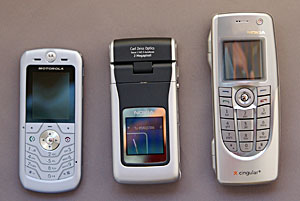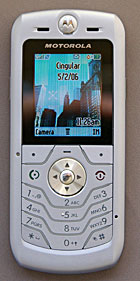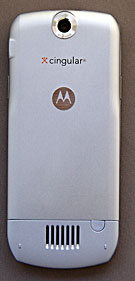|
Advertisement
|
Home -> Phone Reviews -> Motorola SLVR L6
Motorola L6
Editor's rating (1-5):    
Discuss this product
Where
to Buy
Reviewed May 16, 2006 by Jacob Spindel
SLVR Style
Although Motorola's marketing people probably felt that SLVR sounded better than "SLAB," the phone truly is, in fact, a small, thin, rectangular slab measuring just 4.33" x 1.93" x 0.41" and weighing about 3.3 ounces- in other words, its form factor is virtually identical to the ultra-slim SLVR L7, which we reviewed here. Style-wise, it's the candy bar cousin to the Motorola RAZR clamshell phone.
Indeed, with its screen, D-pad, and buttons on the front, a VGA camera on the back, and a couple of configurable extra buttons on the sides, the design retains a simple, minimalist style while retaining a sense of elegance and advanced technology. There is nothing to flip, bend, or rotate, which enhances the phone's durability in some ways since it is all one solid piece, although this also means that its screen is completely exposed and unprotected unless you keep the phone in a case.
On the phone's right-hard side, you'll find the SLVR L6's only physical connection port, a standard USB mini-B 5 pin plug. This connection is used both for charging and for connecting with a computer to access the L6's 9 MB of available internal memory. It's a relief to see a standard connector instead of "Proprietary Cell Phone Port That Was Probably Discontinued 8 Years Ago v1.2 (not compatible with 1.1)" - which is important, since the phone doesn't accept any type of flash memory card.
For Mac users, the phone is compatible with Apple iSync, which allows you to synchronize contacts and calendars via Bluetooth or USB.
Finally, the 720 mAh lithium-ion battery on the back of the phone is user-replaceable and provides about 5.15 hours of talk time, or 15.5 days on standby.
While the L6 lacks the L7's super-slick metal keypad, higher quality display and iTunes, it sells for a price anyone can afford.
SLVR Specs
The L6 is a Quad-Band GSM phone, supporting the 850, 900, 1800, and 1900 MHz bands. This means you can use it throughout the world wherever GSM service is available. The phone is compatible with GPRS class 10 but not EDGE.
I found that the L6 produced ample volume and clarity for virtually any situation, regardless of whether I used the built-in speaker, the built-in speakerphone capability, or a Bluetooth headset. The phone received a clear signal throughout the urban area in which I tested it.
The phone itself has a responsive user interface that never feels sluggish although Cingular does not specify what type of CPU it uses.

Comparing the L6 to the Nokia N90 and Nokia 9300 smartphones.
SLVRscreen
The L6's screen sports 128x160 pixels, capable of displaying up to 6 lines of text, as well as graphics, in 65,000 colors. Overall, the screen is very bright and clear, with graphics looking crisp instead of blocky like some phones. It's a CSTN display rather than the high end 262,000 color TFT used on its pricier brother the L7, but it still looks good. When playing back videos or other rapid motion, the image is choppy compared to most PDAs and high end phones thanks to the CSTN's slower response time, but it's still watchable and reasonably impressive by cell phone standards.
Bluetooth Banter
I had no trouble using a wireless headset with the L6's Bluetooth. It paired quickly and easily and worked reliably. However, although the phone also theoretically supports DUN (dial up networking), I was unable to access the Internet from either my Mac or my Pocket PC. Depending on the settings I used, I consistently received an error stating that either "the modem has unexpectedly hung up" or "no carrier detected."
SLVR Snapshots
Cingular advertises the L6's built-in, video-capable camera as being "VGA resolution," a term which is sometimes confusing to some users. Perhaps the reason they don't use a megapixel rating is that a VGA resolution, meaning 640 x 480, only amounts to about 0.3 megapixels. As small as that may sound, though, the L6's camera makes reasonably good use of the pixels it has, providing a fairly clear picture, as well as the ability to digitally zoom in up to 4x. Although you wouldn't be able to use the SLVR L6's camera to create a panoramic masterpiece, for occasional snapshots it gets the job done.
|
|
 |
 |
Sample photos from the L6 camera, unedited other than resizing to fit this page.
SLVR Stamina
The lithium-ion battery included with the SLVR L6 is rated at 720 mAh, and in my tests, it proved to be a true workhorse. Even after over an hour of extensive use, the charge level remained above 80%. Cingular says that the battery provides a total of 5.15 hours of talk time, or 15.5 days of standby, on a single charge, and judging from my tests, this is a fairly accurate estimate. The battery is located at the back of the phone, and is user replaceable.
SLVR Software ("TIKR?")
The L6 features the KJava virtual machine, which is compliant with J2SE MIDP 2.0-level Java applets. This gives it substantial extensibility in terms of adding new programs. Although most of the built-in software is pretty standard (camera, instant messenger, etc.), I found one feature in particular, called the "Ticker," to be innovative and useful. The Ticker is exactly what you would probably guess: a rotating information display on the main screen, which can provide you with information about local weather, sports scores, and a variety of news and entertainment information. Several free channels are included, although some of the optional channels will incur an additional monthly fee (usually less than $1 per month). Since it has content that is actually valuable even without paying extra, the Ticker is a truly handy feature. The only real downside is that if you use the Ticker, the L6 is much more likely to access its network even when it's not in use, without you doing anything—so be cautious of what effects it may have on your data plan.
Motorola's web browser, though better than the Nextel Motorola i870 I reviewed recently, is still rather abysmal when accessing anything other than WAP sites. Fortunately, one thing it did perfectly was downloading and installing Opera Mini 2, and once I had this installed, it resulted in a truly excellent web browsing experience. Pages loaded quickly, and I was able to visit a wide variety of my usual HTML-based sites instead of trudging through dozens of sites and trying to find "the one that works." Typing on a cell phone isn't much fun, and rendering accuracy is still nothing like a desktop's browser (or even a PDA's), but this setup is useful enough to actually get you out of a jam in those times when you suddenly realize you've forgotten to bring along some key information.
The phone includes built-in e-mail and instant messenger software for selected providers, but if you want to use one that isn't included, you'll have to find an add-on Java program (and probably pay extra) or find a web-based interface that will work on the phone.
The standard features for purchasing and downloading ringtones and wallpaper images worked quickly and effectively. Ringtones can be monophonic, polyphonic, or actual recorded sound, but other than that, the phone's music playback capability is virtually nonexistent.
Is the SLVR a KEEPR?
Unlike its big brother the L7, the SLVR L6 doesn't have iTunes, or any other new flagship feature that is unique to its particular model, but it solidly combines the majority of features popular with consumers without sacrificing the quality of the individual features. In particular, Bluetooth headset support, the Ticker, long battery life, and the bright screen make the L6 a good choice for mid-range consumers—even though the naming scheme is a bit "vowel challenged."
Pros: A very stylin' and function phone for not much cash. Nice screen and audio quality; handy Ticker feature; slim and attractive form factor.
Cons: Built-in mail program only works with a few providers; camera could've been better.
Price: Currently sold exclusively by Radio Shack for Cingular, ~ $79.99 with a 2 year contract, $279.99 without contract
Web sites: www.radioshack.com, www.hellomoto.com
Shopping: Where to Buy
|
Display: 128 x 160 pixel
CSTN color LCD.
Battery: Lithium
Ion rechargeable. Battery is user replaceable.
720 mAh.
Performance: Undisclosed processor. Approximately 10 megs internal memory.
Size: 4.45 in x 1.93 in x 0.43 inches. Weight: 3.3 ounces.
Phone: GSM quad band world phone, 850/1800/1900MHz with GPRS class 10 for data.
Camera: VGA
Audio: Built
in speaker, mic and 2.5mm standard headset jack.
Networking: Integrated
Bluetooth.
|
|
|





